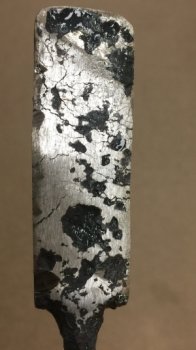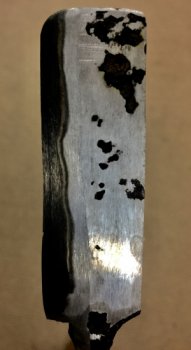You are using an out of date browser. It may not display this or other websites correctly.
You should upgrade or use an alternative browser.
You should upgrade or use an alternative browser.
1st San Mai Billet
- Thread starter KenH
- Start date
OK, I tried again for San Mai, this time using .138" thick 1095 for center core. I put a .120" side of 416 on one side, and just to see what AEB-L would do I used .062" thick on other side. This to give SS clad 1095. From what I can see the AEB-L didn't work so good, it's the side with all the cracks. Take a look below - what caused the cracks? What the temp too high? OR - perhaps AEB-L just isn't good for San Mai?
This billet is after cutting 1/4" or so from each edge and leaving what is seen. I'm pretty sure that is the AEB-L in .062" material.
This below is the other side with .120" thick 416 SS. This side looks good. What is the narrow shiny line just below the line of 416? What I see is the cladding of 416SS, then a thin line of black, then the shiny line, then rest is the black oxide on 1095.

Any ideas why the line is there? Why the other side cracked so much?
Thanks for any comments.
Ken H>

This billet is after cutting 1/4" or so from each edge and leaving what is seen. I'm pretty sure that is the AEB-L in .062" material.
This below is the other side with .120" thick 416 SS. This side looks good. What is the narrow shiny line just below the line of 416? What I see is the cladding of 416SS, then a thin line of black, then the shiny line, then rest is the black oxide on 1095.

Any ideas why the line is there? Why the other side cracked so much?
Thanks for any comments.
Ken H>
Jason Volkert
Well-Known Member
I think that shiny line is from carbon migration. So basically that line is pure iron. Don't quote me I could be wrong though
Jason Volkert
Well-Known Member
You got me wanting to go fire up my forge right now. Cool stuff thanks for sharing!!
JeremyBartlett
Well-Known Member
Hey Ken nice work on the first billet! I'm a little confused though...you said the core is 15n20, but 15n20 doesn't etch black it's the shiny part of the damascus we make when paired with 1084/1095/1075.
For the 2nd attempt....when trying to forge weld stainless to anything you need to make sure that it is an oxygen free environment. Most people do this by mig/tig welding completely around the billet to seal it completely off. At a hammer-in Bill Wiggins once took a piece of tailpipe put his stack inside it crimped the ends and forged it all together then removed the tailpipe. Myself, I make small tack welds, the put the stack in stainless foil and double wrap it. Any of these methods should get you much better results....let me know how it goes!
For the 2nd attempt....when trying to forge weld stainless to anything you need to make sure that it is an oxygen free environment. Most people do this by mig/tig welding completely around the billet to seal it completely off. At a hammer-in Bill Wiggins once took a piece of tailpipe put his stack inside it crimped the ends and forged it all together then removed the tailpipe. Myself, I make small tack welds, the put the stack in stainless foil and double wrap it. Any of these methods should get you much better results....let me know how it goes!
@Jason: Thank you for info, I was wondering if that was something like that. I do like the line - to me it looks neat. Here is something that I read elsewhere that confirms what you said: "The shiny layer at the lamination would be the now carbon-deprived 1095 (iron) and the black line is the (now) carbon-rich stainless. It migrated from the carbon-rich 1095 to the carbon-lacking stainless at the high forge welding temps probably a few thousandths or so on each side which is mated up against the other." That makes sense because the line shown is only on the side with 416 which has .15% carbon, while the other side with AEB-L with .67% carbon doesn't show the line.
@Jeremy: Thanks for the input Jeremy, I realize 15N20 is used in Damascus for the shiny part, but I'm sure it was 15N20 used for the core with first attempt. I ordered 15N20 and 1095 from AKS to play with. I did a double check after the first attempt and all the 1095 was still there, only the 15N20 was missing so it had to be 15N20 used on the first attempt.
On the 2nd attempt with 416 and AEB-L I followed the same procedure as with the first. I fresh ground flat all interior sides of metal, washed with denatured alcohol, clamped tight in vise and welded all around to seal billet. While billet was still hot from welding I put in forge to heat.
Putting the stack inside a tailpipe would work great I'm sure, but would require a lot more hammering with my arm to forge the tailpipe as well as the stack. I had heard about using a double wrap of SS foil, but decided to weld all around the perimeter to seal interior from the air. So far I'm getting really good welds with no delams, other than right at the edges 'n ends.
@Jeremy: Thanks for the input Jeremy, I realize 15N20 is used in Damascus for the shiny part, but I'm sure it was 15N20 used for the core with first attempt. I ordered 15N20 and 1095 from AKS to play with. I did a double check after the first attempt and all the 1095 was still there, only the 15N20 was missing so it had to be 15N20 used on the first attempt.
On the 2nd attempt with 416 and AEB-L I followed the same procedure as with the first. I fresh ground flat all interior sides of metal, washed with denatured alcohol, clamped tight in vise and welded all around to seal billet. While billet was still hot from welding I put in forge to heat.
Putting the stack inside a tailpipe would work great I'm sure, but would require a lot more hammering with my arm to forge the tailpipe as well as the stack. I had heard about using a double wrap of SS foil, but decided to weld all around the perimeter to seal interior from the air. So far I'm getting really good welds with no delams, other than right at the edges 'n ends.

